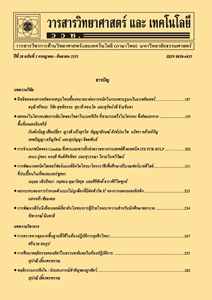Potential of Heating Energy Generation of Municipal Solid Waste: A Case Study of Promlok Municipality
Main Article Content
Abstract
This research aims to study electrical energy providing from waste by combustible waste and non-combustible waste to solve the problems of municipal solid waste management. Research study includes physical and chemical elements of waste, heat from combustion waste with bomb calorimeter, and the production of methane from non-combustible waste by two-stage anaerobic digestion. The result indicated that waste in Municipality Promlok was an average amount of 3.47 tons per day, with organic waste 41.67 percent by weight, and plastic 25.83 percent by weight. The waste can be classified as the combustible waste, non-combustible, and trash with 43.33, 48.33 and 8.33 by weight of waste, respectively. The composition of combustible waste consisted of moisture (36.94 %w/w), total solids (63.06 %w/w), and volatile solids (19.02 %w/w). Those of non-combustible waste were 77.79 %w/w moisture, and 22.21 %w/w total solids. The non-combustible waste was mixed with methane-producing inoculum for biogas production. The effect of non-combustible waste loading (3, 5, 7, 9, and 11 %w/w) on the performance of hydrogen and methane production via two-stage anaerobic digestion was investigated. Two-stage anaerobic digestion of non-combustible waste of municipality Promlok was found maximum hydrogen, and methane production for 3 (%w/w) substrate loading has the largest concentration of 3 percent municipal waste. The methane production was 114.76 m3-CH4/tonne-VS, with a heating energy potential of 418.63 kWh/day. At the same time, the electric production potential of combustible waste was 2,729.62 kWh/day.
Article Details
References
Wongchantra, P., Wongchantra, K., Boottarat, S. and Sanprasit, A., 2016, The training manual of recycle waste management for undergraduate students, Environmental Education Programs, Mahasarakham University, Prae-wa Kalasin J. Kalasin Univ. 3(3): 98-112. (in Thai)
Yingyuad, N., 2017, Development of knowledge and awareness in garbage management for students major of agricultural and environmental Education through participation between university, local school and community network, Veridian E-J. Silpakorn Univ. Human. Soc. Sci. Arts 10(1): 770-785. (in Thai)
Kittivitayapong, R., 2019, Competency on integrated municipality solid waste management of people in Prachuap Khirikhan Province, VRU Res. Develop. J. Human. Soc. Sci. 14(1): 298-311. (in Thai)
Pongsiri, T., Toopgrajank, S. and Rungsawanpho, D., 2018, Administration patterns model establishment for collecting and transferring of local municipal solid waste, Veridian E-J. Silpakorn Univ. Human. Soc. Sci. Arts 11(1): 1572-1587. (in Thai)
Pollution Control Department, 2016, Thailand State of Pollution Report 2016, Pollution Control Department, Bangkok, 540 p. (in Thai)
APHA, 1998, Standard Methods for the Examination of Water and Wastewater. 20th Ed., American Public Health Association, American Water Works Association and Water Environmental Federation, Washington DC, 1220 p.
Kiatsiriroat, T., Prasityousil, J., Prasityousil, J., Vorayos, N. and Nanthaphan, A., 2009, Feasibility Study of Waste Management for District Scale Electricity Generation, Faculty of Engineering, Chiangmai University, Chiangmai, 423 p. (in Thai)
Saranrom, K. and Yongcharoen, W., 2015, A case study of a waste processing plant fuel establishment in Nonthaburi municipality, Nonthaburi province, J. Energy Res. 12(2): 36-46. (in Thai)
Hinsui, T., 2013, Alternative: A Study on Municipal Solid Waste Disposal by Plasma Gasification Technology for Energy Recovery, Doctoral Dissertation, Suranaree University of Technology, Nakhon Ratchasima, 243 p. (in Thai)
Drake, M., 2017, Qualitative determination of energy potential and methane veneration from municipal solid waste (MSW) in Dhanbad (India), Energy 123: 386-391.
Khongkliang, P., Kogjan, P. and O-thong, S., 2015, Hydrogen and methane production from starch processing wastewater by thermophilic two-stage anaerobic digestion, Energy Proc. 79: 827-832.
Bumrerpong, P., Penchai, P. and Ongwandee, M., 2014, Effect of organic loading rate on methane production and methane production inhibitors in food waste using a two-stage digester, J. Sci. Technol. Mahasarakham Univ. 33(1): 8-12.
Brown, D., Shi, J. and Li, Y., 2012, Comparison of solid-state to liquid anaerobic digestion of lignocellulosic feedstocks for biogas production, Bioresour. Technol. 124: 379-86.
Lahaman, A., Niyasom, C. and O-thong, S., 2012, Effect of temperature and organic loading on methane production from hydrogenic effluent of oil palm mill wastewater, Thaksin Univ. J. 15(3): 107-115.
Sohgratok, N., 2013, Biogas production from decanter cake of palm oil mill with wastewater from frozen seafood industry, Master’s Thesis, Prince of Songkla University, Songkla, 157 p. (in Thai)
O-Thong, S., Boe, K. and Angelidaki, I., 2012, Thermophilic anaerobic co-digestion of oil palm empty fruit bunches with palm oil mill effluent for efficient biogas production, Appl. Energy 93: 648-654.
O-thong, S. and Mamimin, C., 2014, Enhancement of Hydrogen and Methane Production from Palm Oil Mill Effluent by Two-stage Anaerobic Digestion, Faculty of Science, Thaksin University, Phatthalung, 60 p. (in Thai)
Raktakanit, K., 2015, Organic waste management using anaerobic digestion technology in Thailand, National Defence College of Thailand J. 57(1): 68-81.
Li, Y., Zhou, L.w. and Wang, R.Z., 2017, Urban biomass and methods of estimating municipal biomass resources, Renew. Sustain. Energy Rev. 80: 1017-1030.


